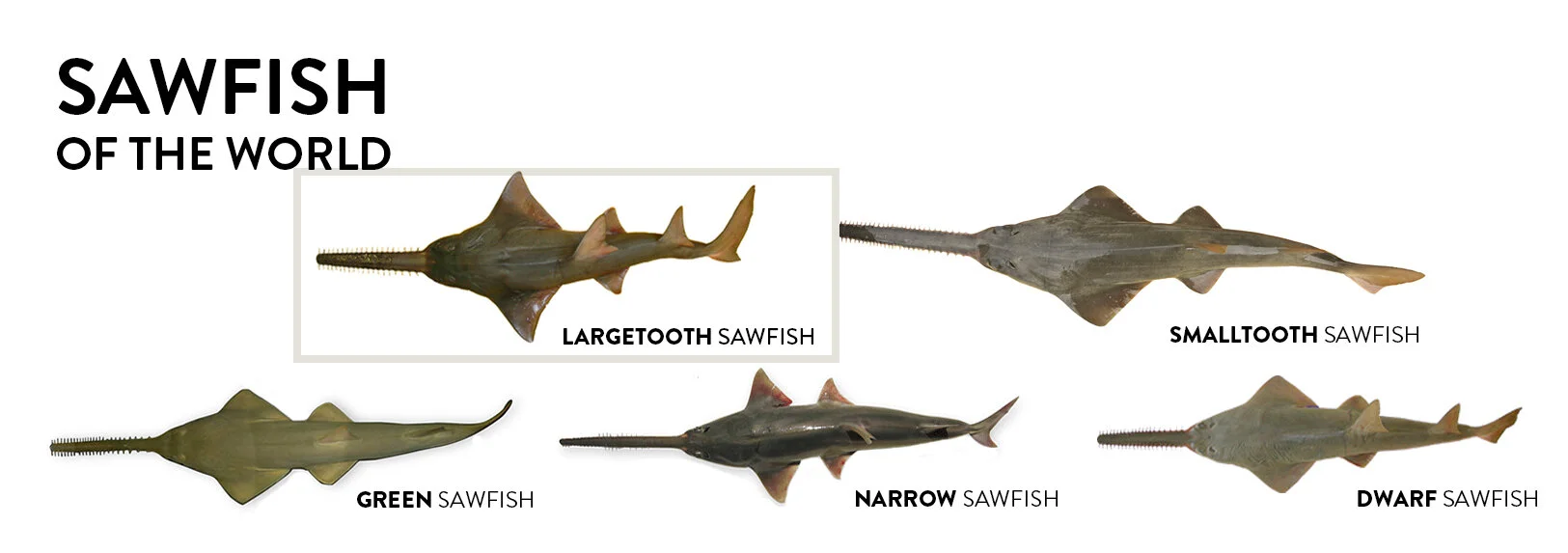
LARGETOOTH SAWFISH / Pristis pristis
The largetooth sawfish (Pristis pristis), also known as the freshwater sawfish, is one of the largest sawfishes that reaches lengths of around 700 cm (i.e. 23 feet). It is visually distinct from other sawfishes in that the start of its first dorsal (top) fin is well in front of the start of its pelvic (underneath rear) fins, the presence of a smaller lobe on its caudal (tail) fin, and relatively wide rostrum (in adults) with evenly spaced rostral teeth. This is the only sawfish that is found worldwide in tropical and subtropical waters. Juveniles use freshwater rivers and lakes as nurseries, while adults typically move into nearshore marine waters. This species was previously considered to be multiple species (i.e. P. microdon, P. perotteti, and P. zephyrus). The IUCN has listed the largetooth sawfish as Critically Endangered. Read below for further information.
Largetooth sawfish (Pristis pristis) - Dean Thorburn
LARGETOOTH SAWFISH DESCRIPTION
Color: Olive-brown dorsally and white ventrally.
Fin position/markings: Start of first dorsal fin is in front of the start of the pelvic fin (Taniuchi et al. 1991b, Compagno and Last 1999, Thorburn and Morgan 2005a, Last and Stevens 2009, Faria et al. 2012). Relatively wide pectoral fins. Lower caudal fin lobe small but apparent (Ishihara et al. 1991, Taniuchi et al. 1991a, Compagno and Last 1999). No anal fin.
Rostral meristics and morphology: Relatively wide rostrum, with standard rostrum width (SRW) being 15-25% of standard rostrum length (SRL). Left and right rostral tooth counts of 14-24, which vary regionally and between sexes (Thorson 1973; Ishihara et al. 1991, Taniuchi et al. 1991a, Compagno and Last 1999, Faria et al. 2012, Whitty et al. 2013). Female rostral tooth counts are typically smaller than that of males (Thorson 1973, Ishihara et al. 1991, Thorburn et al. 2007, Whitty et al. 2013). Left and right rostral tooth counts do not significantly differ and differences in these counts range from 0-2 (Ishihara et al. 1991,Thorburn et al. 2007, Whitty et al. 2013). Standard rostrum length and total rostrum length (TRL) were found to range from 19-26% and 20-28% of total length (TL) (Faria 2007, Whitty et al. 2013), gradually decreasing with size (SRL = 0.0733TL1.1683 for juveniles) (Whitty et al. 2013). Distal most (near rostrum tip) rostral tooth gap is 50-100% that of the proximal most (near base) rostral tooth gap (Whitty et al. 2013). Groove on posterior margin of rostral teeth extends to base (Miller 1974, Thorburn et al. 2007). Second most distal rostral tooth gap smaller than most distal rostral tooth gap (Whitty et al. 2013).
Size: Pupped between 73 and 91 cm TL (Thorson 1976, Compagno and Last 1989, Thorburn et al. 2007, Peverell 2008). Attain an estimated maximum length of 600-700 cm TL (Peverell 2008, Last and Stevens 2009), with the largest recorded individuals at 705 cm TL (Devadoss et al. 1989) and 700 cm TL (Charvet-Almeida 1999).
Vertebral Count: 213-230 (226-228 in northern Australia; 218-228 in Sepik River, Papua New Guinea; 213-230 in Lake Murray, Australia) (Taniuchi et al. 1991b, Taniuchi et al. 1991a).
LARGETOOTH SAWFISH HABITAT
Distribution: The largetooth sawfish occurs in tropical and subtropical waters throughout the world. Northern Australia appears to be one of the last strongholds for the species. Populations in Asia and Africa are likely to have become locally extinct, although individuals are still observed in recent years in countries such as Brazil, Oman, India, and Bangladesh. See Faria et al. 2012 for further information.
Habitat: Juveniles inhabit rivers (up to 400 km upstream of river mouths) and lakes for three to five years (Thorson 1982; Thorburn et al. 2007). In rivers, smaller juveniles occur in shallower waters than larger individuals (Whitty et al. 2008, 2009). At night juveniles have been found to move into shallow water, presumably to forage, and moved to deeper waters during the day, often remaining under ledges and overhanging trees (Whitty et al. 2017).
Near maturation, juveniles begin to move into estuarine and marine waters (Thorburn et al. 2007). Adults have been found near river mouths (hypothesised pupping grounds) during the wet season (Peverell 2005). Adults have been captured in depths between 5-50 m. In Central America, adults were observed to inhabit the freshwater Lake Nicaragua for extended periods (Thorson 1982). It is unclear if these individuals remained in the lake since birth, but evidence from tagging suggests that at least a small percent of these individuals move into the ocean (Thorson 1982).
LARGETOOTH SAWFISH LIFE HISTORY
Age and growth: Tanaka (1991) estimated a k-value of 0.066 per year (Linfin = 363 cm, t0 = -4.073) for largetooth sawfish in the Indo-West Pacific, using observed data from juvenile largetooth sawfish with a von Bertalanffy growth curve. This k-value suggests growth to be approximately 18 cm within the first year and 10 cm in the tenth year. Peverell (2008) calculated a k-value of 0.08 per year (Linfin = 638 cm, t0 = 1.55), using similar methods with largetooth sawfish up to 582 cm TL. This k-value suggests growth to be 52 cm within the first year and 17 cm in the fifth year. In Central America, Thorson (1982) suggested P. pristis to grow 35-40 cm in the first year and 12 cm in the tenth year. However, this information was estimated based on the assumed maximum TL of 430 cm. From data provided by Thorson (1982), Simpfendorfer (2000) calculated a P. pristis k-value of 0.089 per year (Linfin = 456 cm, t0 = -1.98 yrs).
Maximum age has been estimated to be approximately 80 yr (638 cm TL), with growth asymptoting at 35 yr (606 cm TL) (Peverell 2008). Thorburn et al. (2007) estimated P. pristis of 100 cm, 140-160 cm, 180-220 cm and 230-280 cm TL to be around one, two, three and four years of age, respectively, using vertebral analysis. Peverell (2008) produced similar age estimates via similar methods (83-101 cm, 119-140 cm, 143-180 cm, 170-219 cm, 229-253 cm and 234-277 cm TL are 0+, 1+, 2+, 3+, 4+ and 5+ years olds, respectively). Peverell (2008) also found a 582 cm TL female to be 28 years of age.
Reproduction: Aplacental viviparity (lecithotropic nutrition) (Stevens et al. 2005; Last and Stevens 2009). Litters of 1-13 pups (Thorson 1976; Peverell 2008). Peverell (2008) suggested the largetooth sawfish to pup annually. However, Thorson (1976) found approximately half of mature females to not be pregnant and suggested pupping to occur every other year. Gestation period is about five months (Thorson 1976). In Australia, pupping appears to occur in the wet season (December to March) (Peverell 2005; Whitty et al. 2008, 2009a). In Central America, pupping occurs in the wet season from October to December (Thorson 1976).
Maturity: Males mature between 240 and 300 cm TL, females mature at around 300 cm TL (Thorson 1976; Compagno and Last 1998; Thorburn et al. 2007; Peverell 2005, 2008; Whitty et al. 2008).
LARGETOOTH SAWFISH DIET
Juvenile largetooth sawfish captured in rivers in Western Australia were found to consume lesser salmon catfish (Neoarius graeffei), cherabin (Macrobrachium rossenbergii), insect parts, molluscs, nematodes and other unidentified fishes (Thorburn et al. 2007). Gut contents of largetooth sawfish captured in marine, estuarine and freshwater habitats in Queensland, Australia included cherabin (Macrobrachium spp.), prawns (Penaeus spp.), fork-tailed catfish (Arius spp.), eel-tailed catfish (Tandanus spp.) and scaly croaker (Nibea squamosa) (Peverell 2008).
LARGETOOTH SAWFISH GENETICS
Genetic diversity (i.e. haplotype diversity and allelic richness) was found to be moderate for largetooth sawfish (Phillips et al. 2011). The levels of genetic diversity in the microsatellite loci were found to be very similar in the Fitzroy River, Western Australia and the Gulf of Carpentaria, Queensland (Phillips et al. 2011). Much of the genetic diversity in the Fitzroy River are present as rare alleles (Phillips et al. 2011).
Phillips et al. found no evidence of genetic subdivision in P. pristis between the Fitzroy River, Western Australia and the Gulf of Carpentaria, Queensland (Phillips et al. 2009b, 2011). While maternal gene flow between these regions was found to be negligible, the amount of gene flow between these two regions has been sufficient to prevent structuring in the nuclear genome (Phillips et al. 2008, Phillips et al. 2009b, Phillips et al. 2011). These results suggest that largetooth sawfish may have male-biased dispersal (Phillips et al. 2009b, 2011). Watanabe (1991) found little genetic structure between populations in Australia and Papua New Guinea through comparisons of lactate dehydrogenase isozyme patterns in largetooth sawfish. However, Watanbe's (1991) results should be treated with caution due to the small sample size (n = 12) used and because isozymes are less variable than other markers.
LARGETOOTH SAWFISH CONSERVATION
Population estimates are unknown. However, largetooth sawfish assemblages have been observed to have greatly declined throughout their documented range, being extirpated in some areas while other populations have retracted in range (Stevens et al. 2000; Pogonoski et al. 2002; White and Kyne 2011). The Lake Nicaragua population was observed to have greatly decreased/collapsed in the 1970's and has yet to recover (McDavitt 2002). Northern Australia appears to be one of the last known regions with viable populations.
The largetooth sawfish is listed as Critically Endangered by the IUCN. This species is completely protected in Australia (listed as vulnerable by the EPBC Act and as no-take species in Western Australia, Queensland and the Northern Territory) and India. As with all sawfish species, the largetooth sawfish is listed as Appendix I species by CITES, preventing international trade.




